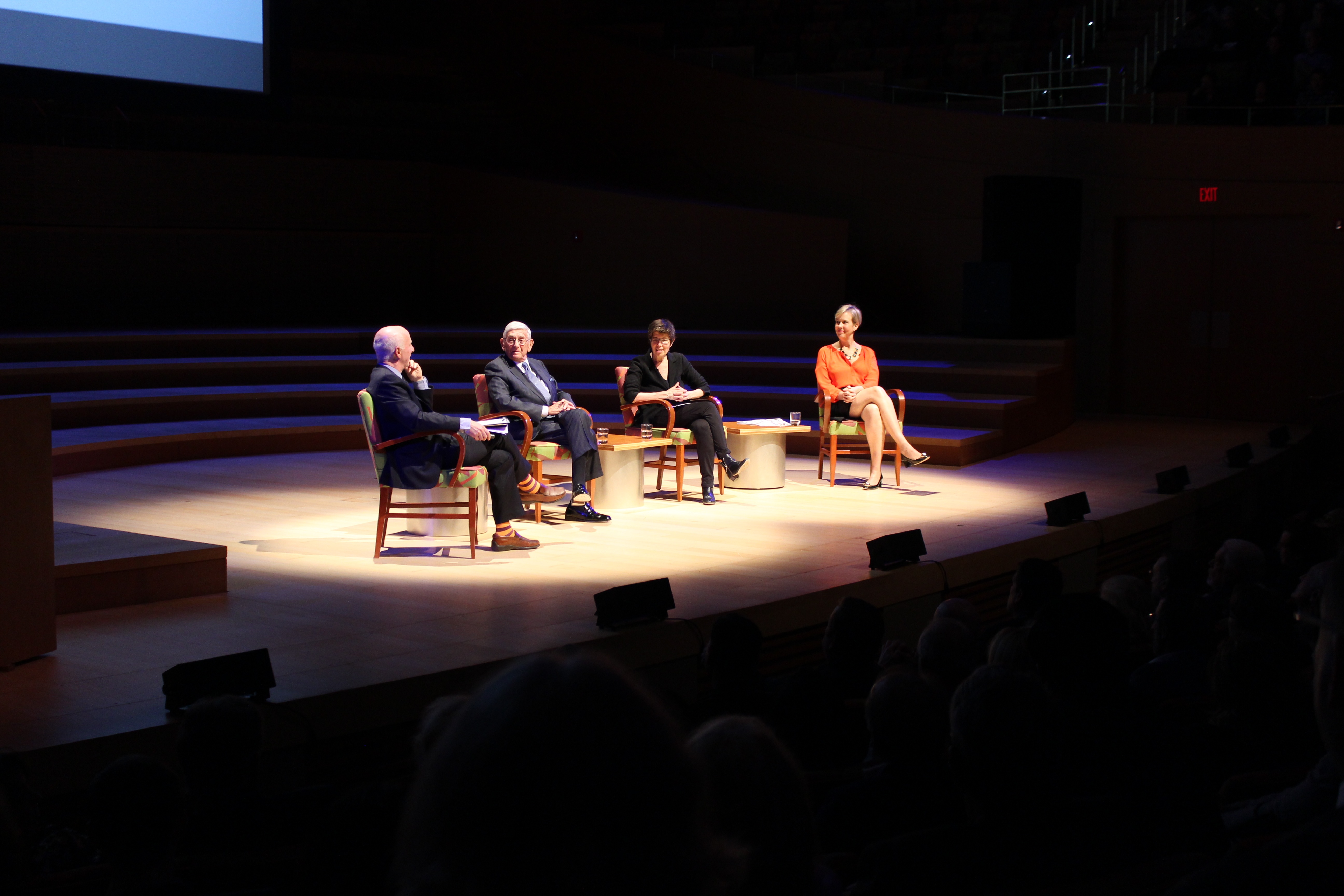In many ways, Monday evening’s “Un-Private Collection” panel/conversation at Disney Hall, featuring The Broad Museum’s principal architect, Elizabeth Diller, of the Diller, Scofidio + Renfro firm of architects, and moderated by the distinguished architecture critic, Paul Goldberger, was the capstone of the series – certainly to date, and possibly for some time to come, assuming the series continues in some form over the next few years. “Un-Private” might well describe the Broad Art Foundation’s ‘art practice’ over most of its life up until The Broad Museum’s debut: ‘private,’ but functioning as a quasi-public/institutional ‘lending library’ with some limited public access. Diller was joined by Eli Broad, seated next to her in the center, and flanked on her left by the Broad’s Director, Joanne Heyler.
The Broad/DSR’s problem was two-fold – the second half of it essentially self-imposed by Eli Broad upon himself, in keeping with his ambitions not just for his Museum, but for the Bunker Hill neighborhood and the downtown area generally. The first problem was to exteriorize functions that had been distinctly ‘interior’; to make public what had previously functioned as a discreetly functioning private lending institution. The second was to contextualize it within a distinctly urban public space and, not incidentally, augment that space’s importance and vibrancy. The jury may still be out as to whether that second goal will actually be achieved; but Paul Goldberger noted that a hotdog cart had recently staked claim to a patch of sidewalk outside the Museum, which in New York street terms, was something of an endorsement of its viability as a locus of urban activity. So far the demand for admission tickets has been almost overwhelming (fully booked through January); and attendance is at capacity.
Diller was originally surprised that her firm was invited to submit a proposal to the Broad team. “We thought we had absolutely no chance.” She summed up the principal challenges. “One was Eli. The others were architectural.” She characterized Eli’s secondary agenda in much broader terms, as an “intention to urbanize downtown L.A.” – not necessarily easy to do with what might have been conceived as a storage facility. It was the first aspect she dealt with, by “attack[ing that functional problem] head on” – to “make the storage facility the center of the building.” Another problem was its high-profile street site – its closest neighbor being, Frank Gehry’s glamourous Walt Disney Concert Hall. Goldberger (whose biography of Frank Gehry was recently released) commented, “You can’t fight with it; you won’t win.” Diller’s approach was to work with the specific configuration of the site – in contrast to Disney Hall’s dazzling and sometimes reflective surfaces, making it “more modest, not as exuberant;” “much more about absorbing light,” which was consistent with the practical objective of bringing light and people into the building. (It felt just a bit ironic to be listening to this discussion from Disney Hall.)
Diller, along with Goldberger and Heyler, then went on to discuss the way that light would be filtered into the building – through the construction of its honeycombed ‘veil,’ taking advantage of its 45 degrees off true-north orientation and creating idiosyncratic views and perspectives from behind its windows, along with a full acre of column free space on the third floor. All took some satisfaction at the contrast between the ‘drama’ of the entrance and the escalator up and a coexisting conviviality and serenity at the third floor. “I hope you never do anything crazy up there,” said Diller.
Diller, whose practice almost up until the time of the firm’s 2003 Whitney Museum retrospective had been largely conceptual, was even more surprised to have been ultimately selected. She noted, though, that she and Broad had met at the retrospective – which also took place at the same time work had begun on the firm’s first museum, Boston’s ICA. Heyler, in turn, has now shepherded three museum projects to completion, having been involved previously with both the Renzo Piano BCAM project at LACMA and the Zaha Hadid-designed Eli and Edythe Broad Museum at Michigan State University.
The audience had to be struck at the conviviality and serenity that seemed to rule on stage at Disney Hall. Diller gave full credit to Eli for having “imagined it in his brain,” to begin with; but the process of designing and building the Museum was surely harrowing. Diller and Broad locked horns only briefly at the very end, but not entirely in jest. Asked what they might have done differently, Eli responded, “Well, it was a bit over budget….” Diller shot back, “I wish you’d dialed up the budget a bit.”
Watching Diller and Heyler alongside Broad, and bearing in mind the Hadid-designed museum at MSU, I couldn’t help thinking about another woman’s pertinent advice—now a catch-phrase: Lean In. Broad certainly imagined and enabled this vision; but Diller and Heyler (along with a small army of designers and builders) were charged with executing it. It was exhilarating to bear witness to this acknowledgment of an achievement that was clearly as much their own as Eli Broad’s.


